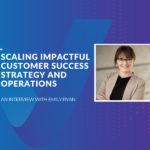Driving NDR With Customer Success Operations
As a fairly new discipline, Customer Success (CS) Operations is ripe with opportunities for companies to improve how they support customers and, in turn, increase revenue retention and expansion. A robust CS Operations function enables a smooth and streamlined experience for your customers, creates efficiencies for your CS team and empowers your organization to drive Net Dollar Retention (NDR) at scale. Through a strategic mix of people, process, technology and data, CS Operations is the beating heart of every enterprise B2B organization. If your CS Ops team isn’t properly and fully enabled, you may be putting your ability to drive sustainable and scalable recurring revenue growth at considerable risk.
To help you realize the full potential of this revenue engine, we turned to 3 CS Operations leaders at the top of the field; Karin Stewart, Customer Journey Lead at Splunk, and Megan Macaluso, Senior Director of CS Strategy & Transformation at Convercent. Karin and Megan recently spoke to our CCO, Emily Ryan, on her new CS Operations LinkedIn Series and shared their expertise on how to make your CS organization more efficient and supercharge your company’s Net Dollar Retention. Together, they share a bold vision for creating a cutting-edge Customer Success Operations function that exponentially expands your revenue and growth potential.
Tip 1: Cultivate An Operational Mindset
“Implementing CS Operations principles within an existing organization, such as a Revenue or Sales Operations team, is a good starting point,” shares Emily. “But, what’s really going to drive long-term impact is formalizing a distinct department. Customer Success is designed to retain and expand your customer base, so employing a CS Operations Leader, whose sole focus is driving value for your customers, can improve your churn metrics and ensure Gross Revenue Retention (GRR) and Net Dollar Retention growth.
Creating a sub-organization dedicated to Operations is all about clarity, consistency and scale. If you’re a relatively small company, you can get away with all hands on deck. But, if you’re enterprise-sized or mid-market and growing rapidly, I strongly recommend having at least one seasoned practitioner on your Operations side, if not an entire team, dedicated to finding efficiencies and processes that drive scalability and revenue growth.”
Tip 2: Manage Expectations & Set Priorities With Senior Leadership
“When Senior Leadership understands the power of a CS Operations function, they see the vast opportunities that accompany the discipline. In my experience, they get extremely excited and want to do everything,” attests Karin. “While that enthusiasm is great, it’s usually not feasible given resource constraints. Instead, it’s important to come up with a plan and start simple. Accomplish one or two operational objectives and ensure that this change is successfully implemented, both within your organization and for your customers.
I’m a big believer in planning, but I’m also a big believer in Agile development. Regardless of how robust your plan is, inevitably there will be some roadblocks and changes along the way, whether that’s because of a shift in business objectives, conflicting planning cycles within your organization or new information. The trick to navigating these unexpected occurrences is being thorough in your planning and obtaining leadership buy-in so that when you do have to pivot, you can precisely articulate the effort level and resources required to make that shift and identify the initiatives that need to be put on hold in the interim.”
Tip 3: Collaborate Cross-Functionally
According to Karin, “Cross-functional collaboration and communication is vital. There are many teams outside of your CS Operations function that impact a customer’s success so you need to have an overall process in place to help all of these teams collaborate and work together. You also need a system to collate data from all of these traditionally disparate teams in order to create a cohesive view of your customer.”
“SaaS is a team sport,” shares Megan. “If any one team is out of sync, that impacts the overall Customer Experience (CX). The unfortunate reality is that CS is often tasked with owning customer health and retention but they can’t do it on their own. You need to enable your Customer Success organization by bringing all of your customer-facing teams and their insights together, including Product, Marketing, Sales and Revenue. This will equip your organization with the insights and information they need to deliver a cohesive and exceptional customer experience.”
“Valuize has recently launched the ValueXperience framework which reframes the responsibility of driving NDR from CS alone and makes it a shared organizational responsibility,” adds Emily. “Your CS Ops function should be tapped into your Product, Marketing and Sales ecosystems. I’ll use an analogy that helps to shift the mindset around CS Operations: think about a McLaren car. It’s a beautiful car that makes you feel like you’re part of an exclusive club but, at the end of the day, the Sales rep hands you your keys and leaves you to it. If you think about the other part of McLaren’s business, it’s Formula 1. Formula 1 is SaaS. Your customer is driving but it’s not really their car, they rely on their pit crew, coaches and engineers as well as the data that comes out of the car. That’s exactly like CS; we have so many businesses that are transforming from selling cars off the lot to Formula 1 and it’s more of an organizational transformation than they initially expect – it impacts your Finance, Sales, Marketing teams and everyone in the business.”
Tip 4: Deliver A Cohesive Customer Experience
“Each and every touchpoint for your customers represents a moment of experience. Together, these singular moments combine to determine their overall impression of your business,” states Megan. “Whether they talk to their CSM, visit your website or deal with a Salesperson, all of this is one experience to your customers. Delivering that cohesive experience successfully depends greatly on your processes, team and tech stack, all of which requires strategy, planning and continuous improvement.“
Tip 5: Leverage Your Data For The Most Impactful Operational Approach
“Dig into your leading and lagging indicators to spot gaps and areas for improvement,” urges Megan. “Look at your customer journey and determine the key areas that require operational support. For example, your data may indicate that you need to improve your renewals process and develop a powerful tech touch program for a segment of your customers in order to reduce your Cost to Serve, improve the customer experience and support scale. In this case, you’ll need to determine the processes you need to enable that and how you’re going to report on its impact on your team and your customers. Identify those priority areas first, and develop an operational plan to tackle these issues accordingly.”
Tip 6: Have Results-Driven Conversations To Get Executive Buy-In
According to Megan, “Some CS leaders struggle to have the right conversations with senior executives and communicate their needs effectively. In order to facilitate these discussions, you need to speak their language. This is where metrics come in. You’re asking your leaders to make an investment, so it’s imperative that you understand what’s important to them and articulate your needs and impact through numbers.
The other place where I see eyes light up is when you talk about the results that you can drive with a CS Operations function enabled with the right team and resources; things like tech touch programs, an effective renewals process and lead generation.”
“The CFO, CRO and CCO – these folks talk in numbers and metrics, dollars and value,” states Emily. “If you’re a strategy and operations leader who isn’t talking in terms of money, and specifically NDR, you’re missing out on big opportunities to secure buy-in.”
Tip 7: Learn From Other Successful Companies
“Learn from success,” recommends Megan. “There are companies out there that are implementing Operations in a powerfully effective way. Find an example, whether that’s through use cases or a TSIA membership, that you can benchmark your organization against and use to show your leadership the impact that a fully functional and enabled Operations function can have.”
Tip 8: Drive Transformation With Operations At The Core
“If you want to go from a foundational place, to an operational place, and ultimately to a transformational place, you need the right people, process, technology and data analysis capabilities,” recommends Megan. “CS has a significant charter in regards to renewals and the growth of a customer. To meet these hefty goals, you need a team that is able to forecast customer health, predict and understand risk, and clearly report and articulate these insights to determine the appropriate next steps. Doing all of that successfully requires operational involvement and oversight.”
Accelerate Growth With A CS Operations Transformation
Customer Success Operations is the backbone of your SaaS organization. Taking advantage of its vast revenue-generating potential starts with investing in the right team, tools and processes. By building a high-caliber CS Operations function, you will be able to optimize the impact, efficiency and scalability of your Customer Success organization in pursuit of market-leading NDR.
If CS Operations is a recurring revenue engine, then data is the fuel. Follow these 4 steps to effectively leverage your data to better understand your customers and maximize value delivery across the customer journey.





